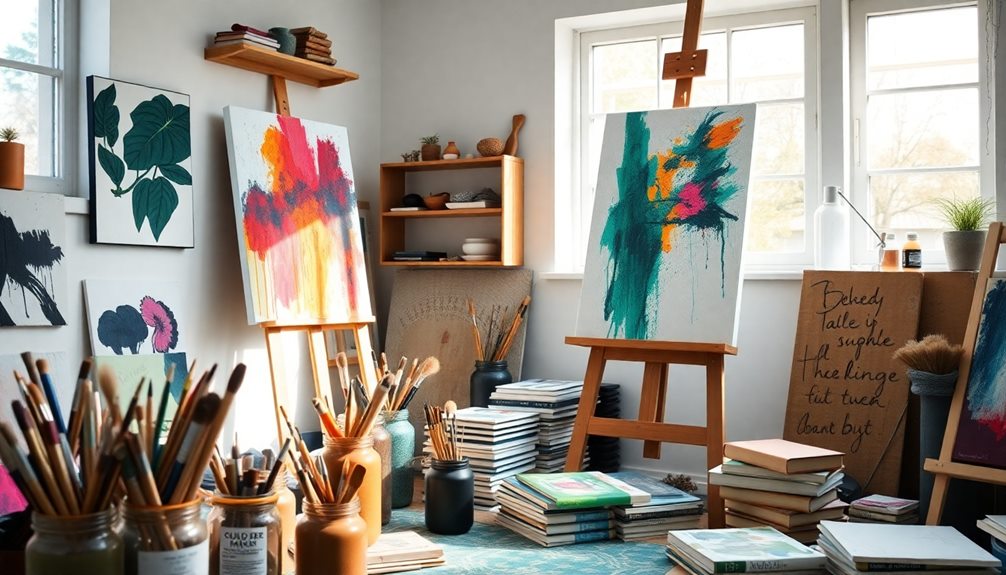To effectively appreciate and critique art, you need a solid understanding of art description vocabulary. Familiarize yourself with key concepts like color theory, composition, and texture. Knowing terms such as "chiaroscuro" or "impasto" will enhance your ability to convey emotions and artistic techniques. Recognizing different art movements also adds depth to your discussions. Practice using precise language to describe colors and textures to create a vivid narrative around the artwork. This vocabulary will enrich your critique and invite deeper connections with art. Keep exploring to discover more ways to elevate your art appreciation skills.
Key Takeaways
- Familiarize yourself with essential art terminology, including color theory, composition, and texture, to enhance art appreciation and critique.
- Use specific vocabulary to describe colors accurately, such as hue, saturation, and tone, for clearer communication.
- Analyze the composition by assessing symmetry, balance, and arrangement of elements to understand the artwork's visual impact.
- Incorporate terminology from art movements to provide context and depth to your descriptions, enriching audience understanding.
- Engage your audience by inviting their feedback and encouraging discussions, fostering personal connections to the artwork.
Introduction

When you explore art, understanding the vocabulary that describes its various elements is essential for deep engagement. This vocabulary helps you analyze and articulate the qualities of a work of art, including its color, composition, texture, and form. By familiarizing yourself with terms like complementary and analogous color relationships, you can better appreciate how colors interact within an artwork.
Moreover, the use of natural materials and earthy color palettes can evoke feelings similar to those found in art, creating a sense of warmth and serenity in the space, reminiscent of Balinese interior design.
Knowing compositional techniques such as balance and unity allows you to discuss how different elements come together to create harmony or tension. Surface qualities, like matte or glossy finishes, can dramatically affect the viewer's perception and emotional response to the piece.
As you dive deeper into art movements and styles, such as Impressionism or Abstract Expressionism, you'll gain context that enhances your understanding of artistic evolution and techniques. Using precise vocabulary not only enriches your discussions but also fosters a more nuanced interpretation of artistic intentions and impacts.
This knowledge transforms your experience, enabling you to communicate effectively about visual experiences and appreciate the complexities of each work of art.
Key Concepts and Definitions

Art vocabulary includes a range of key terms that relate directly to the elements and principles of art, which help in understanding composition. Familiarizing yourself with these elements, such as line, shape, and form, is essential for grasping how visual organization impacts an artwork's overall effectiveness.
Additionally, concepts from sound design fundamentals can provide insights into how audio elements enhance storytelling and emotional engagement in visual art forms. Understanding color theory is equally important; it covers concepts like hue, value, and intensity, along with relationships such as complementary and analogous colors. These concepts influence how viewers perceive emotion and mood in art.
Moreover, recognizing different artistic movements, like Impressionism and Abstract Expressionism, allows you to appreciate varying styles and philosophies that have shaped art history. Each movement introduces unique approaches to the elements of art, adding depth to your understanding.
Essential Art Terminology Breakdown

Understanding essential art terminology is key to effectively discussing and analyzing artworks. When you refer to media or medium, you're talking about the materials and tools an artist uses, such as paint, clay, or digital tools. The choice of medium can significantly impact the artwork's final appearance and feel.
For instance, the use of different media can evoke various emotional responses and convey distinct messages, much like how survival skills for new dads enhance the parenting experience.
Next, consider technique, which relates to how these materials are applied. An artist's technique can enhance the expressive effects of a piece, influencing its overall quality and impact.
Another important term is naturalism, an artistic approach that aims to represent subjects as they appear in nature. This focus on realism and accuracy helps viewers connect with the artwork on a deeper level.
Art Critique Scenarios

In the realm of art critique, evaluating a piece requires a keen eye for its formal elements, such as composition, color, and texture. You'll want to focus on the visual elements that stand out, as some may hold more importance than others in conveying the artwork's message.
Consider how the principle of visual organization plays a role in guiding the viewer's eye and creating balance.
When engaging in an art critique, pay attention to the emotional responses evoked by the piece. Ask yourself how effectively it communicates its intended message.
Also, don't forget the historical and cultural context; understanding these aspects can deepen your insights into the artwork's themes and significance.
Using specific terminology related to different art movements can enhance your critique, making your analysis clearer and more impactful.
Remember, constructive feedback is essential. It not only highlights strengths but also identifies areas for improvement, fostering growth for the artist.
Tips and Best Practices

When critiquing artwork, using precise vocabulary is crucial for conveying your insights effectively. Start by describing the color of an object accurately. Instead of using generic terms, opt for specific shades or tones that evoke the true essence of the piece. Incorporate art terminology like "chiaroscuro" when discussing light and shade; this enhances the depth of your critique.
Pay attention to the composition of the artwork. Is it symmetrical or asymmetrical? Describe how elements are arranged in the foreground, middle ground, and background. This gives your audience a clearer picture of the artist's intent.
You might use the common name of a technique, like "impasto," to explain the texture and application of paint, adding layers to your description.
Audience Engagement Insights

Describing artwork effectively not only enhances your critique but also invites the audience into a richer experience. When you focus on audience engagement, you're emphasizing the importance of connecting viewers to the art. Use descriptive vocabulary that highlights color, composition, and texture to evoke emotional responses. This approach fosters a deeper connection between the audience and the artwork, making it more memorable.
Consider incorporating interactive elements like guided discussions or multimedia presentations. These tools make the art experience immersive and participatory, enhancing overall engagement. You can also invite feedback and interpretation from your audience, encouraging personal connections to the artwork. This openness allows for diverse perspectives and rich discussions.
Don't underestimate the power of storytelling techniques when you describe art. By weaving narratives around the artwork, you captivate the audience's attention and create thought-provoking experiences.
Audience Comprehension Barriers

Art can hit a wall when audience comprehension barriers come into play. These barriers often stem from diverse cultural backgrounds, which lead to different interpretations of artistic intent and symbolism. If you lack prior knowledge about art history or specific movements, it can be tough to grasp the context and significance of a piece.
Moreover, the use of specialized jargon or complex terminology in art descriptions can alienate those unfamiliar with the vocabulary, making it hard to connect with the artwork. Your emotional responses to art are subjective, shaped by personal experiences that can sometimes lead to misunderstandings.
Accessibility issues also play a crucial role. Physical limitations or inadequate resources might prevent you from experiencing art in its intended form, further complicating your comprehension.
It's essential to recognize these barriers so you can navigate them effectively. By acknowledging the challenges posed by cultural differences, specialized language, emotional perceptions, and accessibility, you can enhance your understanding and appreciation of art. Engaging with art becomes more rewarding when you can bridge these gaps and foster a deeper connection with the work.
Additional Resources

To enhance your understanding of art, a wealth of additional resources is available at your fingertips. You can access pre-made vocabulary lists tailored to describe various forms of art, from paintings to sculptures and installations. These lists will help you sharpen your descriptive skills effectively.
Engage with interactive learning tools that include quizzes, spelling bees, and vocabulary jam sessions. These activities not only make learning fun but also reinforce your grasp of art terminology and concepts.
If you prefer a more personalized approach, create customized flashcards focusing on specific art vocabulary. This targeted study method allows for efficient memorization of essential terms.
Moreover, stay informed with continuous updates offered by platforms like Vocabulary.com. These updates ensure you have access to the latest art-related terminology, keeping your knowledge fresh and relevant.
You can also integrate these resources with educational tools like IXL Learning, enriching your experience as a student or educator. By utilizing these additional resources, you'll deepen your appreciation and understanding of art, making your discussions and descriptions more engaging and informed.
Frequently Asked Questions
How Do You Describe Art in Words?
To describe art in words, you focus on colors, textures, and forms. You analyze composition and balance, using vivid language that captures the piece's emotional depth and contextual significance, engaging your audience's imagination effectively.
How Do I Write My Art Description?
To write your art description, focus on elements like color and texture. Share the medium used, convey the mood, and highlight the artist's intent. This approach deepens viewers' appreciation and understanding of the artwork.
What Words Help to Describe This Artwork?
To describe this artwork, you'll want to use words that capture its colors, textures, and composition. Think about how it makes you feel, and let those emotions guide your choice of descriptive terms.
What Are the Ways in Describing an Artwork?
When you describe artwork, focus on elements like color, line, and texture. Consider the composition, techniques used, and historical context to enhance your understanding and convey the piece's emotional impact and significance effectively.
Conclusion
In conclusion, mastering art description vocabulary enhances your ability to engage with and appreciate art deeply. By understanding key terms and practicing critiques, you'll communicate more effectively and connect with others in the art community. Remember to stay open-minded and curious, as this will enrich your experience. With the tips and resources provided, you're well-equipped to explore the vibrant world of art and share your insights with confidence. Enjoy the journey!









